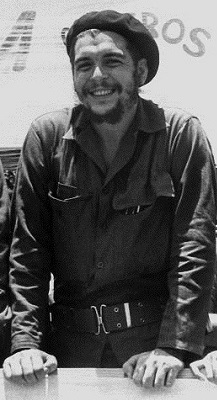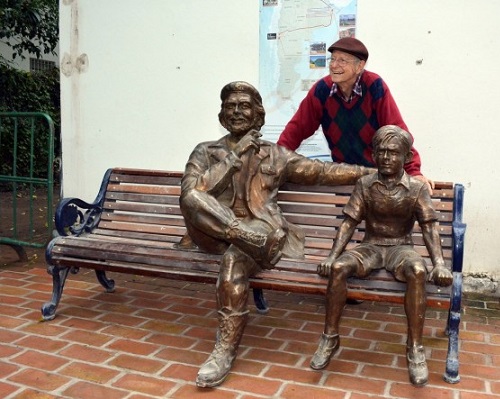|
~ Ernesto Che Guevara
~ Galéria
~ Oldal
~ Bejelentkezés
~ Vissza a Főoldalra
Ernesto Che Guevara, az argentin származású forradalmár, miniszter, gerillavezér és író, Buenos Aires-ben szerzett orvosi diplomát, majd a kubai forradalom során jelentős szerepet játszott a szigetország felszabadításában és újjáépítésében. A kubai gazdaság talpraállításáért dolgozott, küzdött az oktatás és az egészségügy fejlesztéséért, az írástudatlanság és a faji előítéletek felszámolásáért. Saját példájával népszerűsítette az önkéntes munkát. Kongóban és Bolíviában is harcolt - harminckilenc éves volt, amikor az amerikai-bolíviai csapatok csapdába ejtették és kivégezték.
| | |
|

| | |
|
|
|
Che Guevara, una perspectiva del periodismo
|
|
|
For today, you will be given a long and interesting-looking article in Spanish. (And one day I will be able to translate it into English...]
Che Guevara, una perspectiva del periodismo
“El miércoles por la noche el Che Guevara se las arregló para responder a mil preguntas: un enjambre de periodistas lo acribilló sin piedad, y el Che tuvo ocasión de demostrar su habilidad política”. Así describe Eduardo Galeano la conferencia de prensa ofrecida por Che, en su condición de jefe de la delegación cubana, durante la reunión ministerial del Consejo Interamericano Económico y Social, celebrada en Punta del Este, en agosto de 1961.
Esta es, probablemente, la imagen más recurrente en la memoria, ante la idea del vínculo entre Che Guevara y el periodismo: el líder revolucionario de cara a la interrogante, reflexiva o insidiosa, compleja o simple. Che se nos aparece más como entrevistado, enfrente de uno o varios periodistas –cuestionario en ristre-, a través de sus respuestas. Desde la confesión de patria latinoamericana(1), hasta la declaración rotunda de su desinterés por un socialismo sin la moral comunista(2), está el mensaje profundo en sus diálogos con la prensa.
[Read the whole article]
|
|
|


| 2014.05.14. 10:47, Aleida |
A new statue of Che erected in Alta Gracia
|

|
|
The new, life-sized bronze statue is the artwork of the local artist, Luis Hourgras, and it took him a few months to create the portrait of the Comandante, by the help of his students: Julio Incardona, Juana Pontoriero, Flavia Indorado, Miriam Giménez, Claudia Villarreal, Iginia Álvarez, Francisco González, Patricia Gazzia, Irene Chiotti.
The statue will be placed in the garden of the Museo Casa del Che (Che's childhood home in Alta Gracia that has become a museum) and within a few days everyone can admire it. There you can already see the statue of Ernestito, Che as a little boy, sitting on the wall - it was also created by Hourgras.
Source
[Here you can see two photos of the statue]
|
|
|
| 2014.05.12. 10:40, Aleida |
A quiz for You - the correct answers
|
|
|
1. Where did Che study medicine?
A. Córdoba B. Buenos Aires C. Rosario
2. Where did Ernesto and Chichina first meet?
A. At the university B. In the hospital C. On a wedding
3. What did the Guevara family have?
A. motorcycle factory B. yerba maté plantation C. coffee plantation
4. When did Che write these lines?
"I am neither Christ nor a philanthropist, I am exactly the opposite of a Christ... for the things I believe in I fight with all the weapons within my reach and I try to leave my opponent flat on the floor, instead of letting me be nailed to a cross or to any other place."
A. 1959 B. 1961 C. 1956
5. With whom did Che create the Prensa Latina news agency?
A. Camilo Cienfuegos B. Jorge Ricardo Masetti C. Alberto Granado
6. What is Verde Olivo?
A. a building in Havana B. a Cuban magazine C. the name of Che's home in Havana
7. When did Che start Radio Rebelde?
A. 1957 B. 1958 C. 1959
8. Where did Che say these lines?
"Once again we speak out to put the world on guard against what is happening in South Africa. The brutal policy of apartheid is applied before the eyes of the nations of the world. The peoples of Africa are compelled to endure the fact that on the African continent the superiority of one race over another remains official policy, and that in the name of this racial superiority murder is committed with impunity."
A. Punta del Este B. Havana C. New York
9. What happened when Che first met Mao Tse Tung?
A. a Cuban officer accidentally dropped the present they brought to Mao
B. Mao greeted his Cuban guests by talking Spanish
C. Che had a serious asthma attack and fell on the floor
10. In Punta del Este Che met ...
A. Tania B. his family C. Alberto Granado
|
|
|


| 2014.05.11. 09:23, Aleida |
A quiz for You
|
|
|
Here is a little quiz for all the playful visitors of Che Guevara Siempre!
Let's see how well you know Che's life. ;) If you are not sure about the answer, of course you can check them in his biographies.
When you finished, you can send me your replies if you click on "Mit szólsz hozzá?' at the bottom of the post. But in any case, I am going to post the results tomorrow evening.
1. Where did Che study medicine?
A. Córdoba B. Buenos Aires C. Rosario
2. Where did Ernesto and Chichina first meet?
A. At the university B. In the hospital C. On a wedding
3. What did the Guevara family have?
A. motorcycle factory B. yerba maté plantation C. coffee plantation
4. When did Che write these lines?
"I am neither Christ nor a philanthropist, I am exactly the opposite of a Christ... for the things I believe in I fight with all the weapons within my reach and I try to leave my opponent flat on the floor, instead of letting me be nailed to a cross or to any other place."
A. 1959 B. 1961 C. 1956
5. With whom did Che create the Prensa Latina news agency?
A. Camilo Cienfuegos B. Jorge Ricardo Masetti C. Alberto Granado
6. What is Verde Olivo?
A. a building in Havana B. a Cuban magazine C. the name of Che's home in Havana
7. When did Che start Radio Rebelde?
A. 1957 B. 1958 C. 1959
8. Where did Che say these lines?
"Once again we speak out to put the world on guard against what is happening in South Africa. The brutal policy of apartheid is applied before the eyes of the nations of the world. The peoples of Africa are compelled to endure the fact that on the African continent the superiority of one race over another remains official policy, and that in the name of this racial superiority murder is committed with impunity."
A. Punta del Este B. Havana C. New York
9. What happened when Che first met Mao Tse Tung?
A. a Cuban officer accidentally dropped the present they brought to Mao
B. Mao greeted his Cuban guests by talking Spanish
C. Che had a serious asthma attack and fell on the floor
10. In Punta del Este Che met ...
A. Tania B. his family C. Alberto Granado
|
|
|


| 2014.05.10. 08:37, Aleida |
Quotes from the Speech to the First Latin American Youth Congress
|
|
|
For today I have collected some great parts from Che Guevara's speech to the first Latin American Youth Congress.
Here is a little teaser:
"Although it may seem paradoxical, I would also like to greet today the delegation representing the purest of the U.S. people. I would like to salute them because the U.S. people are not to blame for the barbarity and injustice of their rulers, and because they are innocent victims of the rage of all the peoples of the world, who sometimes confuse a social system with a people."
[check out the quotes]
If you liked the quotes and you would like to read the whole speech - which is really worth reading - please click here:
[Speech to the First Latin American Youth Congress].
|
|
|
| 2014.05.09. 09:55, Aleida |
| | |
|
|
|
~ Ernesto Che Guevara
~ Gallery
~ Site
~ Log in
~ Back to the Main page
Ernesto Che Guevara, the Argentine-born revolutionary, minister, guerrilla leader and writer, received his medical degree in Buenos Aires, then played an essential part in the Cuban Revolution in liberating and rebuilding the country. He did his best to set up the Cuban economy, fought for the improvement of the education and the health system, the elimination of illiteracy and racial prejudice. He promoted voluntary work by his own example. He fought in the Congo and in Bolivia - he was thirty-nine years old, when he was trapped and executed by the joint American-Bolivian forces.
| | |
|
|

